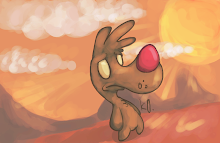Here's some sketches just to get some ideas of the formal aspects of the work. It's not too important what the characters look like, as it's less about paying stylistic homage and more focused on the conceptual ideas behind animation (30s era). I want to get the visuals out of the way for now and focus on concept.
During the 30s era animated frames flowed constantly, even when the character was still, each frame was drawn. Unlike today, when frames stay on the screen longer, when the character is still. The endless constant flow of images gives a feeling of joie de virve. Movement can capture a great deal of expression compared to a still image. If one image was removed from this entire sequence and focused on it would seem entrapped. A still image suggests death; it increases the awareness that a moment in time is being captured. I suppose an example of this is photographs, which are kept so that all who look will remember and ultimately viewers know that the death of the subject is in all human portraits. A still image exists as a memento mori, the firm sign that we will one day die.

I guess there is a play between life and death with animation always. I find that animations I enjoy the most are the ones that are the ones that poke fun at the human condition. I guess I've always related to that, I mean.. Sometimes when I'm sad and crying pathetically, I start laughing at myself. Or sometimes when I hurt myself I laugh. There is humour in all things tragic, there is humour and a light side to everything. There is also some pretty literal symbolism in relation to the black and white era. White - Good, light, life. Black - Bad, dark, death.
I partly want to bring more of a focus to how animation is put together, how it movies.. expanding it just beyond the screen.. Something like Muybridge's sequences or Zoetropes. I'm really interested in the idea of something interactive like a zoetrope. Tomorrow I'm off to the tip to search for inspiration!
